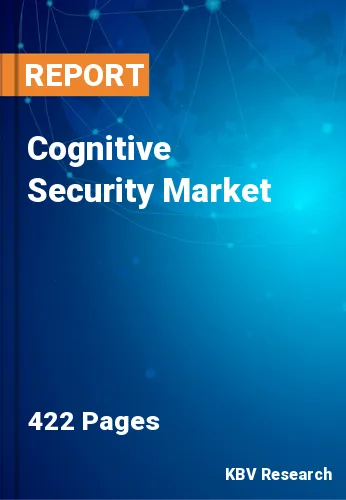
The Global Cognitive Security Market size is expected to reach $16.2 billion by 2023, rising at a market growth of 32% CAGR during the forecast period. Cognitive security is the application of AI technologies, which are patterned based on human thought processes used in detecting threats and protecting physical and digital systems. The self-learning security systems use data mining, pattern recognition and natural language processing methods to simulate human brain, additionally with a high-powered computer model. Growing cases of security breaches and cyber-attacks, and growing adoption of the Internet of Things (IoT) and Bring Your Own Device (BYOD) trends are the key factors that drive the growth of the market during the forecast period.
Based on Type, the Cognitive Security market segments the market into Solution and Services. Solution type includes Unified Log Manager & Data Catalog, Real-Time Security Analytics & Visualization Platform, Biometric Recognition, and Others. Service type includes Professional and Managed Services. Based on Application Area, the market report segments the market into Anomaly Detection & Risk Mitigation, Automated Compliance Management, Threat Intelligence, and Others. Based on Organization Size, the Cognitive Security market segments the market into Small & Medium Enterprises and Large Enterprises.
Based on Security Type, the market report segments the market into Physical Security and Cybersecurity.Based on Vertical, the Cognitive Security market segments the market into BFSI, Government & Defense, Energy & Utilities, Healthcare, Manufacturing, Retail, Telecom & IT, Education, and Others. Based on Regions, the Cognitive Security market segments the market into North America, Europe, Asia Pacific, and Latin America, Middle East & Africa.
The market research report covers the competition analysis of key stake holders of the Global Cognitive Security Market. Key companies profiled in the report include IBM Corporation, Cisco Systems, Inc., CA Technologies, Inc., Symantec Corporation, DXC Technology, Trend Micro, Inc., Fortinet, Inc., Amazon.com, Inc. (Amazon Web Services), Logrhythm, Inc., and Check Point Software Technologies Ltd.
Related Reports:
North America Cognitive Security Market (2017-2023)
Europe Cognitive Security Market (2017-2023)
Asia Pacific Cognitive Security Market (2017-2023)
LAMEA Cognitive Security Market (2017-2023)
Our team of dedicated experts can provide you with attractive expansion opportunities for your business.
